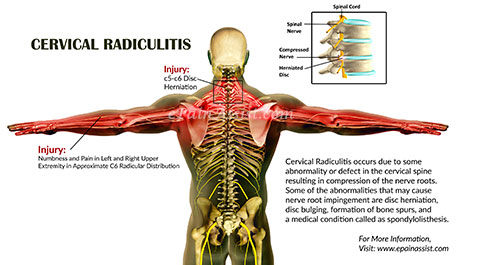What is Cervical Radiculitis?
Cervical Radiculitis is a pathological condition of the cervical spine in which there is irritation or compression of one or more nerve roots present in the cervical spine. Cervical Radiculitis gets its name due to the radiating nature of the symptoms which a patient experiences due to this condition. As the function of the nerve roots of the spine is to promote sensory and motor functions in other parts of the body thus any irritation or compression of these roots results in them sending pain signals spanning across the length of the nerve. Few of the common symptoms caused due to Cervical Radiculitis are shooting and radiating pain from the neck which may go down the neck into the shoulders, upper back, hands and arms along with numbness and tingling across the upper extremities.

What is the Cause of Cervical Radiculitis?
In majority of the cases, Cervical Radiculitis occurs due to some abnormality or defect in the cervical spine resulting in compression of the nerve roots. Some of the abnormalities that may cause nerve root impingement are disc herniation, disc bulging, formation of bone spurs, and a medical condition called as spondylolisthesis. All of these can be caused due to various reasons which include trauma to the cervical spine or degeneration of the cervical spine as a result of age and normal wear and tear of the spine, overuse of the spine by doing activities like sitting in front of the computer for prolonged periods of time or driving for long distances. It may also be caused due to poor body mechanics. In some cases, degeneration of the spine may also have a genetic link to it. Apart from these other risk factors for degeneration of the cervical spine resulting in Cervical Radiculitis are poor posture, smoking, and obese body habitus.
What are the Symptoms of Cervical Radiculitis?

As stated, the main symptom for Cervical Radiculitis is severe pain in the neck region which radiates to the upper extremities including the shoulder, upper back, arms, shoulders, and elbows. The patient suffering from Cervical Radiculitis may also exhibit weakness of the muscles of the neck and upper extremities. There is also presence of numbness and tingling across the upper extremities. Cervical Radiculitis may also affect normal coordination of the hands as well.
How is Cervical Radiculitis Diagnosed?
The best way to diagnose Cervical Radiculitis if a patient presents with radiating pain in the cervical spine is through radiological studies consisting of x-rays, CT scan, and MRI scan.
X-Rays: Plain radiography or x-rays are the first test to be conducted for a diagnosis of Cervical Radiculitis. The images will show degeneration of the disc and may also depict any pathology of the cervical spine.
CT/MRI Scan: This is done when the x-ray studies are not definitive. This scan gives clear visualization of the internal structures of the cervical spine and any sort of impingement or compression of the nerve root can be easily visualized through these scans.
How is Cervical Radiculitis Treated?
Majority of the cases of Cervical Radiculitis are treated conservatively with a combination of physical therapy and antiinflammatory medications. The pharmacological treatments recommended for Cervical Radiculitis are utilizing pain medications or antiinflammatory medications to control pain and inflammation. Non-pharmacological treatments for Cervical Radiculitis consist of physical therapy for stretching and strengthening the cervical spine. Lifestyle modifications in the form of good body mechanics and smoking cessation is also essential is treating the symptoms of Cervical Radiculitis. Invasive treatments in the form of epidural steroid injections are also useful for treating pain symptoms caused due to Cervical Radiculitis but the effect lasts only temporarily. In case if all conservative measures fail to relieve the symptoms of Cervical Radiculitis then the patient may be recommended to undergo surgery to decompress the nerve root and relieve the symptoms caused due to Cervical Radiculitis.
Also Read:
